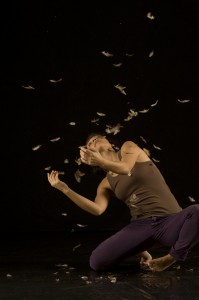MFA Monday: Megan Yankee
 After the Master: Only More Questions
After the Master: Only More Questions
In the last of my articles, I’d like to highlight some of the ideas and articles that have helped me maintain focus in regards to my professional dance career after graduation. After finishing my studies, I was overwhelmed by the challenge of finding, paying for and sustaining three important aspects of a dance career:
- a regular challenging movement practice or class,
- a large and diverse dancing community, and
- a place to rehearse and present my work.
During graduate school, I often reminded myself that the resources available to me at the time wouldn’t last… that I would miss them when they were gone. That wasn’t even the half of it.
I don’t just miss them. At times those things feel completely elusive. At times I feel entirely confounded by how to find or create opportunities that would grant access to these integral parts of a dance career. And in those times of confusion, I end up questioning my decision to build a professional dance career in the first place. After much soul-searching, I settle on more practical questions like the following:
- What is the role of the independent dancemaker in our country?
- How can dancemakers contribute to the wellbeing of a city, state or county?
- What, if any, education should be involved?
- How do you pay for dancemaking?
- How do you nurture a local community through movement?
- How reliable is croundfunding for projects vs. government funding?
I haven’t come to any concrete answers, but, as I said, I have a direction.
I want to convince the city of Columbus that my and others’ dancemaking is a valuable part of a thriving city.
 My direction is likely different from yours, but, for my last blog, I thought I’d share and summarize the articles that have influenced my perspective on the current and potential states of contemporary concert dance in our country. The following are continual sources of comfort and guidance for me. They help me regain a sense of national context for dance that can be elusive when making dance in cities with smaller or non-existence dance communities.
My direction is likely different from yours, but, for my last blog, I thought I’d share and summarize the articles that have influenced my perspective on the current and potential states of contemporary concert dance in our country. The following are continual sources of comfort and guidance for me. They help me regain a sense of national context for dance that can be elusive when making dance in cities with smaller or non-existence dance communities.
If I can no longer make dance at a university or college… If my last resort is creating my own dance community in a city that is new to me, then I’ve found the best way to start is to develop my ability to describe the value and benefits of my dancemaking for the city. These articles provide assistance in doing just that.
The View from Here: A report from The Brooklyn Commune Project on the state of the performing arts from the perspective artists (Abridged) was published in January of this year. I stumbled across it in an article in the Huffington Post by dance artist Nora Younkin which I describe lower down in the list. The BCP, now practically over, continues along as a Facebook group. This report details the nature of funding for the performing arts based both on the authors’ experiences and research from the National Foundation for the Arts. Most importantly, it introduced to me the possibility of considering the performing arts a “public good” due to the many benefits they can provide. Also, here’s a shortened TL;DR version: BKCP Artist Action Flyer
The next link is a summary of a summary. Found on the Rand Corporation’s website, Reframing the Debate About the Value of the Arts is a short article describing the corporation’s new report entitled Gifts of the Muse: Reframing the Debate About the Benefits of the Arts. The summary and research (available on Amazon) both provide me with the language to describe in detail the many benefits of the arts. What is especially helpful is the delineation between instrumental and intrinsic benefits as well as guidance in developing “language for discussing intrinsic benefits that is clear and compelling and reflects the importance of qualitative as well as quantitative issues.”
When I found the next article, I distinctly remember my resulting internal sigh of relief. After a full year of not having produced any work myself (only performing in others’ works), it was comforting to read another dancer’s perspective on the difficulty of sustaining a company or career in dancemaking. Dance and Capitalism: A Love-Hate Relationship was written by dance artist, Nora Younkin and published by the Huffington Post in January of this year. It touches on similar topics as the first article I listed. At times understandably defensive, Younkin both describes her frustration with and details her concerns about the dwindling funding available to contemporary dancemakers. Much like myself and some of the resources I’ve listed, her writing ends in a question: Dance “is asking for validation that [it] has a place in our culture and society worth preserving. So the question is: Does it?”
The next article is a rebuttal to Younkin’s. I found it when reading the comments below her article, which are still available for you to read as well. Who Should Pay for the Arts?: Private support beats public subsidies was written by Jared Meyer for City Journal, a publication that calls itself “the nation’s premier urban-policy magazine.” Because I have lived and worked in North Texas, a part of the country with few funding sources that are available to independent performing artists, I’ve always tried to understand the perspective described by the author in this article. I find it helpful to consider this perspective, as it is those with similar perspectives that I will have the toughest time convincing to help fund my projects.
The final report was produced for the National Endowment for the Arts in 2008 by Jennifer L. Novack-Leonard and Alan S. Brown. Beyond attendance: A multi-modal understanding of arts participation is a summary of survey results conducted in order to better understand the ways in which audiences engage with the arts. It is similar to the first article I listed in that it provides a way of languaging the value of arts, but it’s also helpful to simply provide statistics therein when trying to convince of someone the worth of your projects.
It is my hope that in providing these articles I might incite one reaction from my fellow dancemakers: consider and question your role of the dancemaker in society.
If non-academic resources for dancers dry up, then I worry that it may lead to some form of unintentional creative homogenization in this country. American dancers will have to continue to venture to the coasts to find challenging, inspiring dancemaking communities, leaving the rest of the country in drought. If those who want to make dance are only able to do so in a college setting, then what happens to those dancemakers who can’t go to college? What happens to the dancers that can’t get a job in a college? They may simply become lost artistic voices. Are we willing to let that go as a society?
In the final article in this series next week, we will hear from Amanda McCorkle. Amanda and I graduated together in the spring of last year. Since then, she has taken multiple positions as an adjunct professor in the North Texas area teaching various courses including dance appreciation and hip hop and a few in between. Let us know if you have any questions or comments by emailing me at meganyankeedance@gmail.com.
Megan Yankee (interviewer, writer, curator on MFA Monday) is an indie dance artist that seeks opportunities to make and present dances in alternative spaces in order to expand the reach of concert dance. She is committed to presenting work and curating concerts in houses, busy street corners, warehouses, dance for film, online and in visual art galleries. She has performed and presented work nationally and internationally at the Nomad Express Multi Arts Festival in Ouagadougou, Burkina Faso produced by Olivier, the Sonic Arts Research Center in Belfast, Northern Ireland, American Dance Festival, American College Dance Festival, Texas Dance Improvisation Festival, Movement Intensive in Composition and Improvisation in Lancaster, PA, Emerge and Exchange Dance Festivals in Tulsa, OK, {254} Festival in Waco, Texas, Out of Loop Festival in Addison, TX, and the Rogue Festival in Fresno, CA. She has had the honor of performing in works by Christie Nelson, Amie LeGendre, Larry Keigwin, Michael Foley, Jordan Fuchs, Sandy Mathern-Smith and Sarah Gamblin.
Megan holds (and runs with) an MFA in Dance from Texas Woman’s University and currently lives in Columbus, OH with her partner, John Osburn and their two dogs, Weecho and Lucy.
MFA Mondays